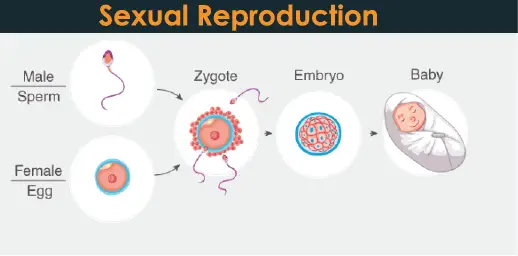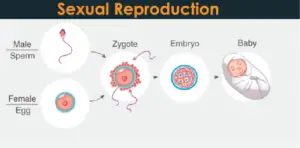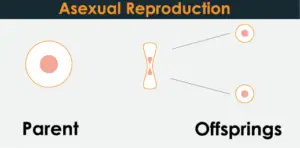
Difference between Sexual and Asexual Reproduction
The very basic and generic difference between Sexual and Asexual reproduction is that Sexual Reproduction occurs in almost all types of multicellular organisms including humans and animals while Asexual Reproduction occurs in lower invertebrates, lower chordates, plants, and many unicellular organisms.
What is reproduction?
Reproduction is a natural process by which organisms produce their offsprings which are the same as them. Organisms here means every living thing here on earth. It is actually a law of nature for the survival of the specie throughout the years. Reproduction is classified into two types which are Sexual and Asexual Reproduction which is our focus topic.
Let us compare the differences between both these terms in the table so You can absorb more from here.
Sexual and Asexual Reproduction in tabular form:
| Sexual Reproduction | Asexual Reproduction | |
| 1. | It occurs in almost all types of organisms that are unicellular including higher plants, humans, and animals. | This occurs only in lower invertebrates, chordates, and plants with simple organizations. |
| 2. | It always includes the fertilization process. | It does not include the fertilization process. |
| 3. | Gametogenesis occurs (formation of gametes). | Gametogenesis does not happen in it. |
| 4. | Always happen bi-parental (father +mother). | Always happen uniparental (from one parent). |
| 5. | Germ cells proceed to perform sexual reproduction. | Somatic cells (normal body cells) proceed to perform asexual reproduction. |
| 6. | A process under the presence of fully developed and functional reproductive organs. | Process in the absence of reproductive organs. |
| 7. | Original parents remain in normal life after the reproduction complete. | The original parent goes disappear after the reproduction complete. |
| 8. | Both mitosis and meiosis I and II can happen, mitosis in somatic cells and meiosis In germ cells. | The only mitosis can happen. |
| 9. | The genetic makeup varies from parent to progeny. | The genetic makeup from parent to progeny will be identical. |
| 10. | Phenotypes of both parents (father + mother) can be seen in the progeny. | Phenotypes of only one parent appear in the progeny. |
| 11. | Hereditary material from both parents first gets mix and they pass on to the next generation. | The hereditary material multiplies and passed on to the next generation. |
| 12. | Multiplication is time taking. | Multiplication is at a rapid pace. |
| 13. | The number of new offspring is less than asexual. | Greater number of new offspring from two to many. |
| 14. | Possess the significance of evolution. | Possess no significance of evolution. |
| 15. | Fertilization, conjugation, and syngamy are the categories of sexual reproduction. | Budding, binary fission, fragmentation, and spore formation are the categories of asexual reproduction. |
also read: difference between gene and allele.
getting bore? no problem I have the solution.
Get a cup of tea or coffee in Your hand and enjoy, this is the solution.
What is Sexual Reproduction Types and Example of Sexual Reproduction?
Sexual Reproduction is actually the production of a new organism by the combination of the genetic material of two organisms of the opposite sex (male and female). When sperm cells (from male) combine the egg cell (from female) it is called fertilization which further gives rise to a new individual.

Types of sexual reproduction include:
- Allogamy.
- Autogamy.
- Internal Fertilization.
- External Fertilization.
Example:
Human is the best example of sexual reproduction which includes internal fertilization. Salmon fish, codfish, and trout use sexual reproduction with external fertilization. Plants use allogamy while paramecium, protozoa, and protists use autogamy. All these are simple & best examples of sexual reproduction.
What is Asexual Reproduction and Types of Asexual Reproduction?
Asexual Reproduction is a reproduction type that doesn’t involve the fusion of gametes of germ cells to produce a new offspring. In this, a new individual is produced and separated from the parental body which can be produced from single-celled or multicellular organisms and is genetically identical to the parent.

Types of Asexual Reproduction are:
- Budding.
- Binary Fission.
- Parthenogenesis.
- Vegetative Propagation.
- Fragmentation
- Regeneration.
- Spore Formation.
Examples of Asexual Reproduction:
Examples of Asexual Reproduction include Amoeba and Bacteria which use binary fission. Hydra uses budding, Planaria uses fragmentation, ferns use spore formation, and onion uses vegetative propagation. These are the best and live examples of Asexual Reproduction and will be easy to memorize.
Importance of reproduction:
Reproduction is a natural process. It is very important for any specie to carry its progeny ahead for decades. Suppose If the concept of reproduction has not existed we could not able to enjoy our lives. Furthermore, it is important for every organism to retain its species on the planet.
Types of reproduction in plants:
There can be Sexual as well as Asexual types of reproduction in plants. Plants are categorized into budding, fragmentation, spore formation, and vegetative propagation if they use to reproduce asexually. If they use sexual, there will be pollination which includes external fertilization of male and female gametes.
Reproduction in human:
There is always sexual reproduction in human: There is internal fertilization of male and female gametes inside the mother. These male & female gametes here are sperm cells from father while the egg from mother fuse and get fertilized which gives rise to a new human inside the mother.
Reproduction in bacteria:
There is asexual reproduction in bacteria. We know bacteria is a unicellular organism and unicellular organisms always use asexual methods of reproduction. The type that bacteria use to divide is binary fission in which a single-celled parent gets divides into two genetically identical daughter cells.
also read: difference between pollination and fertilization